Assessment Task: BSBFIA401 Prepare Financial Reports - Future College
VerifiedAdded on 2019/09/30
|58
|11999
|116
Homework Assignment
AI Summary
This document presents an assessment for the BSBFIA401 unit, focusing on preparing financial reports, conducted at Future College. The assessment includes various activities and knowledge questions designed to evaluate the student's understanding of financial reporting principles, legislative requirements, and organizational policies. The assessment covers topics such as property, plant, and equipment registers, GST regulations, tax agent provisions, and ethical standards. The assessment is divided into several activities including questions, checklists, and practical applications. The student is expected to demonstrate their knowledge of key financial concepts and regulations. The assessment includes sections for skills, knowledge, and performance evaluation, with checklists provided for assessors. The document concludes with a summary of the assessment's components and expectations.
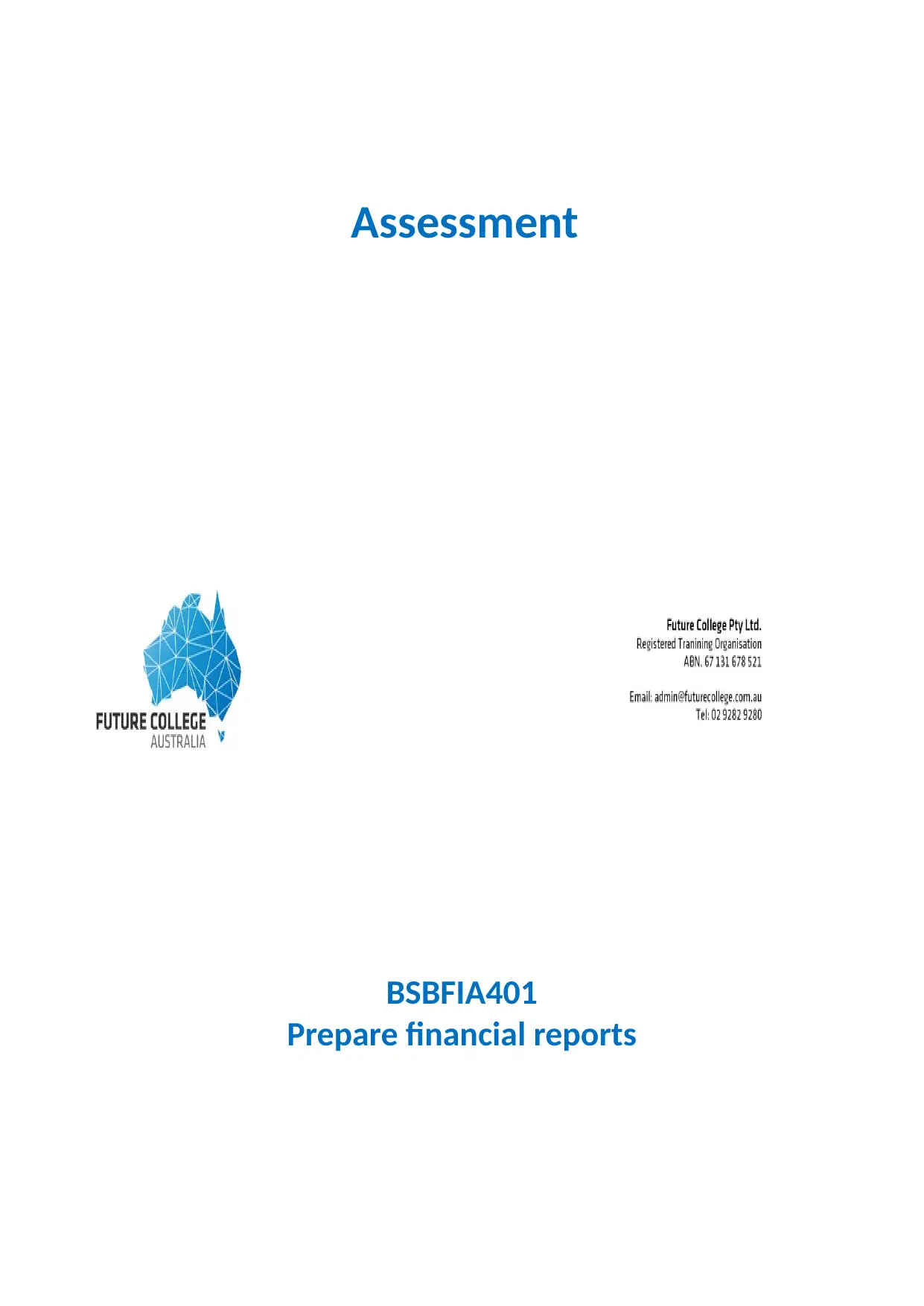
Assessment
BSBFIA401
Prepare financial reports
BSBFIA401
Prepare financial reports
Paraphrase This Document
Need a fresh take? Get an instant paraphrase of this document with our AI Paraphraser
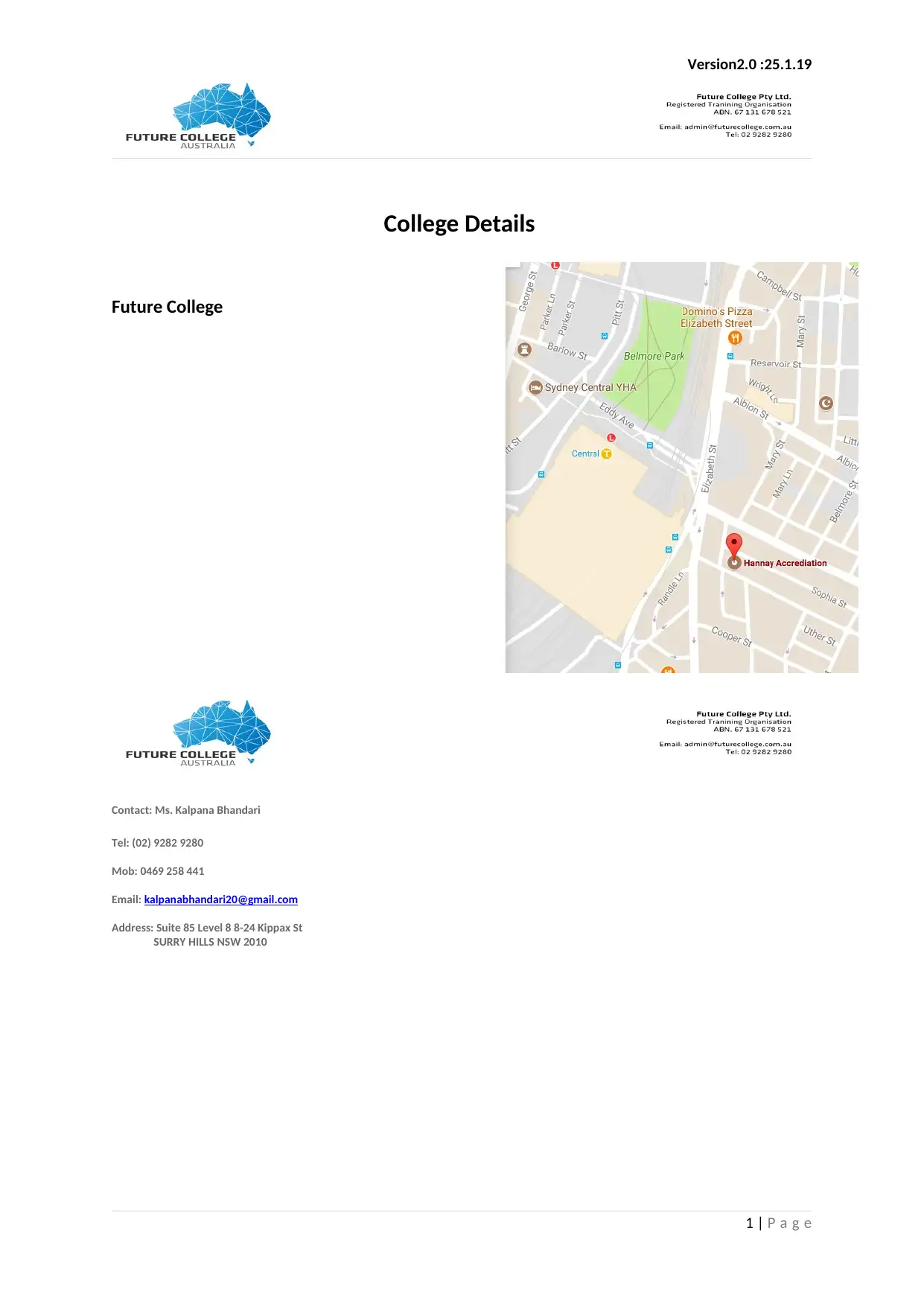
Version2.0 :25.1.19
College Details
Future College
Contact: Ms. Kalpana Bhandari
Tel: (02) 9282 9280
Mob: 0469 258 441
Email: kalpanabhandari20@gmail.com
Address: Suite 85 Level 8 8-24 Kippax St
SURRY HILLS NSW 2010
1 | P a g e
College Details
Future College
Contact: Ms. Kalpana Bhandari
Tel: (02) 9282 9280
Mob: 0469 258 441
Email: kalpanabhandari20@gmail.com
Address: Suite 85 Level 8 8-24 Kippax St
SURRY HILLS NSW 2010
1 | P a g e
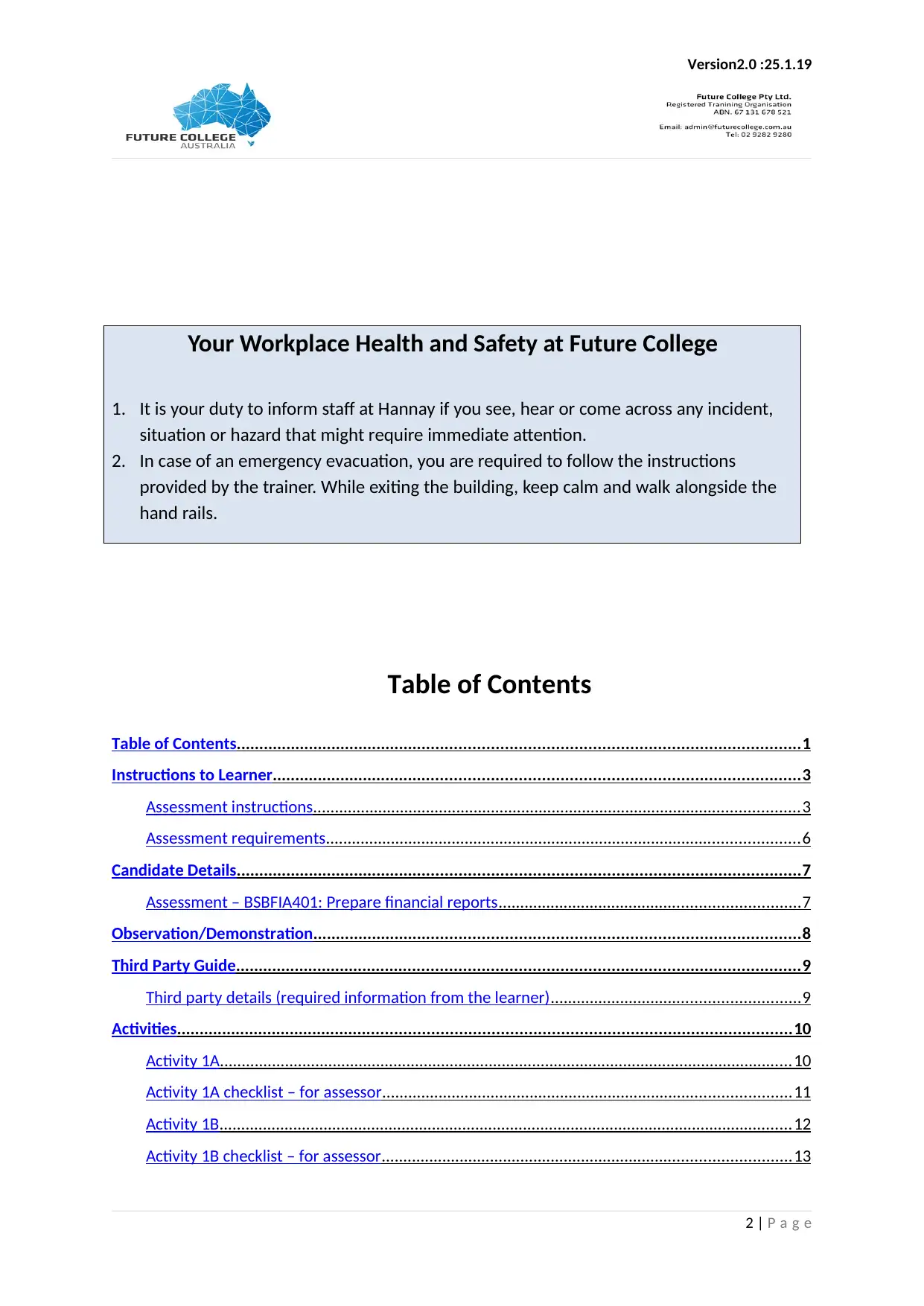
Version2.0 :25.1.19
Your Workplace Health and Safety at Future College
1. It is your duty to inform staff at Hannay if you see, hear or come across any incident,
situation or hazard that might require immediate attention.
2. In case of an emergency evacuation, you are required to follow the instructions
provided by the trainer. While exiting the building, keep calm and walk alongside the
hand rails.
Table of Contents
Table of Contents...........................................................................................................................1
Instructions to Learner...................................................................................................................3
Assessment instructions................................................................................................................3
Assessment requirements.............................................................................................................6
Candidate Details...........................................................................................................................7
Assessment – BSBFIA401: Prepare financial reports.....................................................................7
Observation/Demonstration..........................................................................................................8
Third Party Guide...........................................................................................................................9
Third party details (required information from the learner).........................................................9
Activities......................................................................................................................................10
Activity 1A....................................................................................................................................10
Activity 1A checklist – for assessor..............................................................................................11
Activity 1B....................................................................................................................................12
Activity 1B checklist – for assessor..............................................................................................13
2 | P a g e
Your Workplace Health and Safety at Future College
1. It is your duty to inform staff at Hannay if you see, hear or come across any incident,
situation or hazard that might require immediate attention.
2. In case of an emergency evacuation, you are required to follow the instructions
provided by the trainer. While exiting the building, keep calm and walk alongside the
hand rails.
Table of Contents
Table of Contents...........................................................................................................................1
Instructions to Learner...................................................................................................................3
Assessment instructions................................................................................................................3
Assessment requirements.............................................................................................................6
Candidate Details...........................................................................................................................7
Assessment – BSBFIA401: Prepare financial reports.....................................................................7
Observation/Demonstration..........................................................................................................8
Third Party Guide...........................................................................................................................9
Third party details (required information from the learner).........................................................9
Activities......................................................................................................................................10
Activity 1A....................................................................................................................................10
Activity 1A checklist – for assessor..............................................................................................11
Activity 1B....................................................................................................................................12
Activity 1B checklist – for assessor..............................................................................................13
2 | P a g e
⊘ This is a preview!⊘
Do you want full access?
Subscribe today to unlock all pages.

Trusted by 1+ million students worldwide
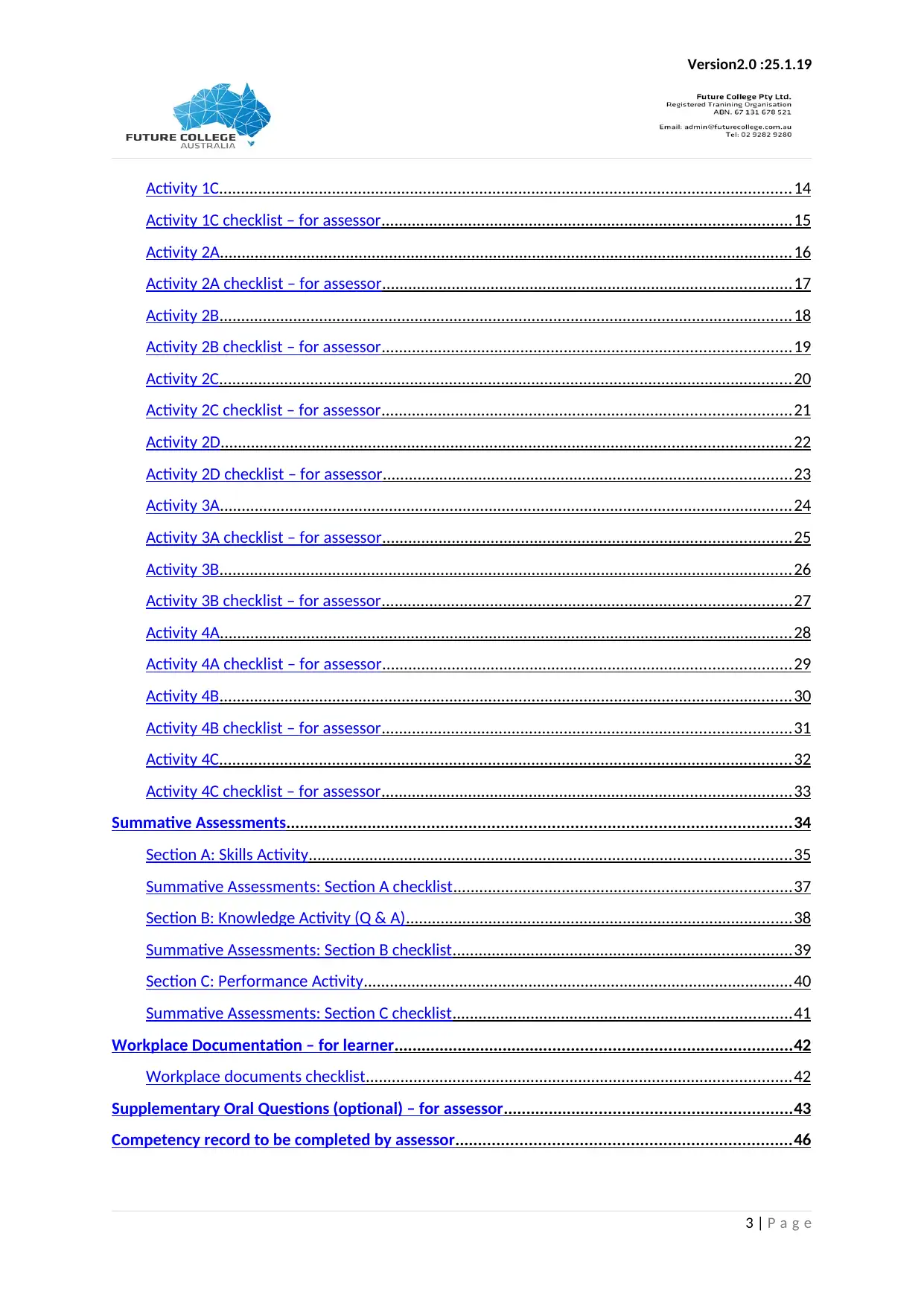
Version2.0 :25.1.19
Activity 1C....................................................................................................................................14
Activity 1C checklist – for assessor..............................................................................................15
Activity 2A....................................................................................................................................16
Activity 2A checklist – for assessor..............................................................................................17
Activity 2B....................................................................................................................................18
Activity 2B checklist – for assessor..............................................................................................19
Activity 2C....................................................................................................................................20
Activity 2C checklist – for assessor..............................................................................................21
Activity 2D...................................................................................................................................22
Activity 2D checklist – for assessor..............................................................................................23
Activity 3A....................................................................................................................................24
Activity 3A checklist – for assessor..............................................................................................25
Activity 3B....................................................................................................................................26
Activity 3B checklist – for assessor..............................................................................................27
Activity 4A....................................................................................................................................28
Activity 4A checklist – for assessor..............................................................................................29
Activity 4B....................................................................................................................................30
Activity 4B checklist – for assessor..............................................................................................31
Activity 4C....................................................................................................................................32
Activity 4C checklist – for assessor..............................................................................................33
Summative Assessments..............................................................................................................34
Section A: Skills Activity...............................................................................................................35
Summative Assessments: Section A checklist..............................................................................37
Section B: Knowledge Activity (Q & A).........................................................................................38
Summative Assessments: Section B checklist..............................................................................39
Section C: Performance Activity...................................................................................................40
Summative Assessments: Section C checklist..............................................................................41
Workplace Documentation – for learner.......................................................................................42
Workplace documents checklist..................................................................................................42
Supplementary Oral Questions (optional) – for assessor...............................................................43
Competency record to be completed by assessor.........................................................................46
3 | P a g e
Activity 1C....................................................................................................................................14
Activity 1C checklist – for assessor..............................................................................................15
Activity 2A....................................................................................................................................16
Activity 2A checklist – for assessor..............................................................................................17
Activity 2B....................................................................................................................................18
Activity 2B checklist – for assessor..............................................................................................19
Activity 2C....................................................................................................................................20
Activity 2C checklist – for assessor..............................................................................................21
Activity 2D...................................................................................................................................22
Activity 2D checklist – for assessor..............................................................................................23
Activity 3A....................................................................................................................................24
Activity 3A checklist – for assessor..............................................................................................25
Activity 3B....................................................................................................................................26
Activity 3B checklist – for assessor..............................................................................................27
Activity 4A....................................................................................................................................28
Activity 4A checklist – for assessor..............................................................................................29
Activity 4B....................................................................................................................................30
Activity 4B checklist – for assessor..............................................................................................31
Activity 4C....................................................................................................................................32
Activity 4C checklist – for assessor..............................................................................................33
Summative Assessments..............................................................................................................34
Section A: Skills Activity...............................................................................................................35
Summative Assessments: Section A checklist..............................................................................37
Section B: Knowledge Activity (Q & A).........................................................................................38
Summative Assessments: Section B checklist..............................................................................39
Section C: Performance Activity...................................................................................................40
Summative Assessments: Section C checklist..............................................................................41
Workplace Documentation – for learner.......................................................................................42
Workplace documents checklist..................................................................................................42
Supplementary Oral Questions (optional) – for assessor...............................................................43
Competency record to be completed by assessor.........................................................................46
3 | P a g e
Paraphrase This Document
Need a fresh take? Get an instant paraphrase of this document with our AI Paraphraser

Version2.0 :25.1.19
4 | P a g e
4 | P a g e
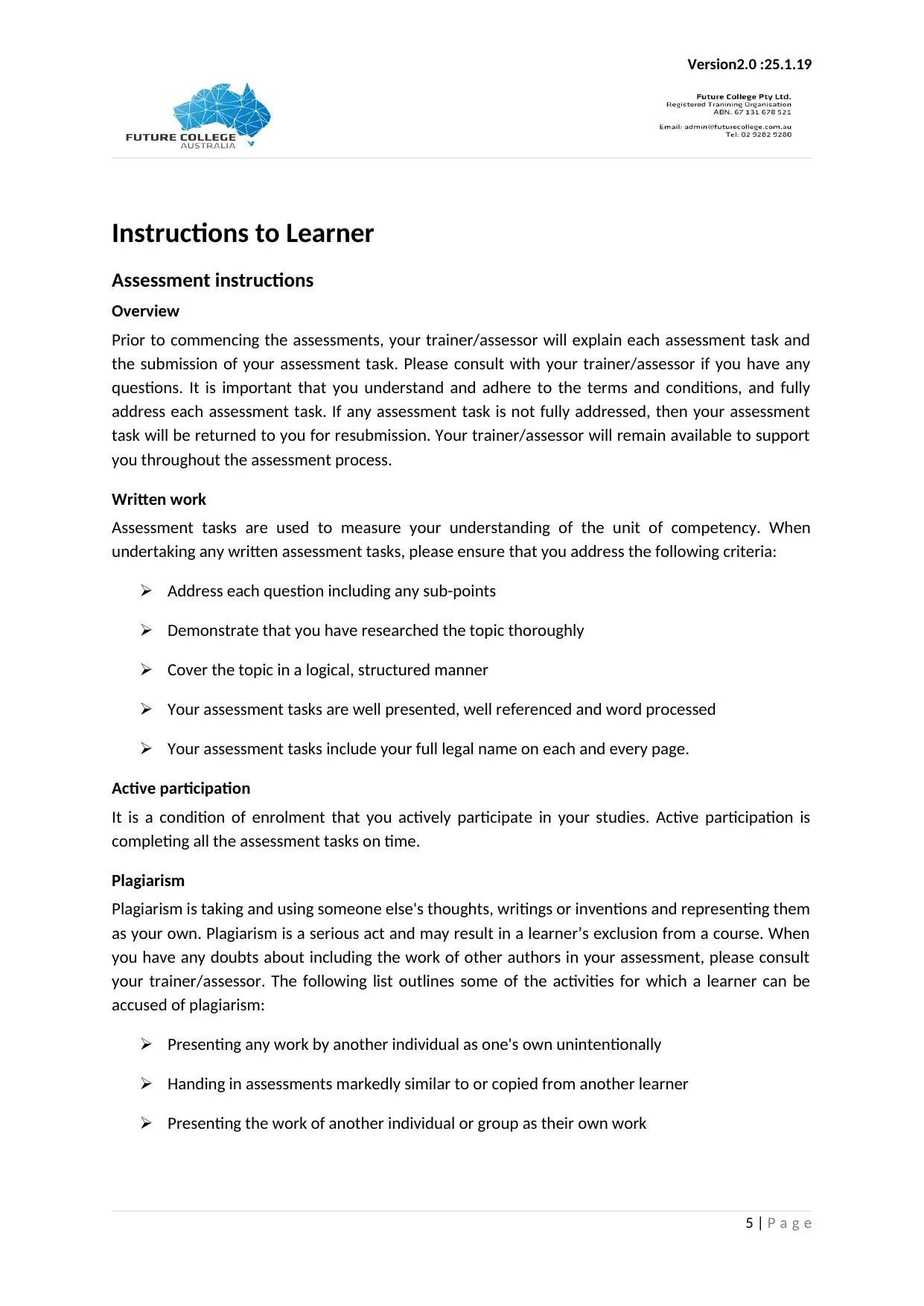
Version2.0 :25.1.19
Instructions to Learner
Assessment instructions
Overview
Prior to commencing the assessments, your trainer/assessor will explain each assessment task and
the submission of your assessment task. Please consult with your trainer/assessor if you have any
questions. It is important that you understand and adhere to the terms and conditions, and fully
address each assessment task. If any assessment task is not fully addressed, then your assessment
task will be returned to you for resubmission. Your trainer/assessor will remain available to support
you throughout the assessment process.
Written work
Assessment tasks are used to measure your understanding of the unit of competency. When
undertaking any written assessment tasks, please ensure that you address the following criteria:
Address each question including any sub-points
Demonstrate that you have researched the topic thoroughly
Cover the topic in a logical, structured manner
Your assessment tasks are well presented, well referenced and word processed
Your assessment tasks include your full legal name on each and every page.
Active participation
It is a condition of enrolment that you actively participate in your studies. Active participation is
completing all the assessment tasks on time.
Plagiarism
Plagiarism is taking and using someone else's thoughts, writings or inventions and representing them
as your own. Plagiarism is a serious act and may result in a learner’s exclusion from a course. When
you have any doubts about including the work of other authors in your assessment, please consult
your trainer/assessor. The following list outlines some of the activities for which a learner can be
accused of plagiarism:
Presenting any work by another individual as one's own unintentionally
Handing in assessments markedly similar to or copied from another learner
Presenting the work of another individual or group as their own work
5 | P a g e
Instructions to Learner
Assessment instructions
Overview
Prior to commencing the assessments, your trainer/assessor will explain each assessment task and
the submission of your assessment task. Please consult with your trainer/assessor if you have any
questions. It is important that you understand and adhere to the terms and conditions, and fully
address each assessment task. If any assessment task is not fully addressed, then your assessment
task will be returned to you for resubmission. Your trainer/assessor will remain available to support
you throughout the assessment process.
Written work
Assessment tasks are used to measure your understanding of the unit of competency. When
undertaking any written assessment tasks, please ensure that you address the following criteria:
Address each question including any sub-points
Demonstrate that you have researched the topic thoroughly
Cover the topic in a logical, structured manner
Your assessment tasks are well presented, well referenced and word processed
Your assessment tasks include your full legal name on each and every page.
Active participation
It is a condition of enrolment that you actively participate in your studies. Active participation is
completing all the assessment tasks on time.
Plagiarism
Plagiarism is taking and using someone else's thoughts, writings or inventions and representing them
as your own. Plagiarism is a serious act and may result in a learner’s exclusion from a course. When
you have any doubts about including the work of other authors in your assessment, please consult
your trainer/assessor. The following list outlines some of the activities for which a learner can be
accused of plagiarism:
Presenting any work by another individual as one's own unintentionally
Handing in assessments markedly similar to or copied from another learner
Presenting the work of another individual or group as their own work
5 | P a g e
⊘ This is a preview!⊘
Do you want full access?
Subscribe today to unlock all pages.

Trusted by 1+ million students worldwide
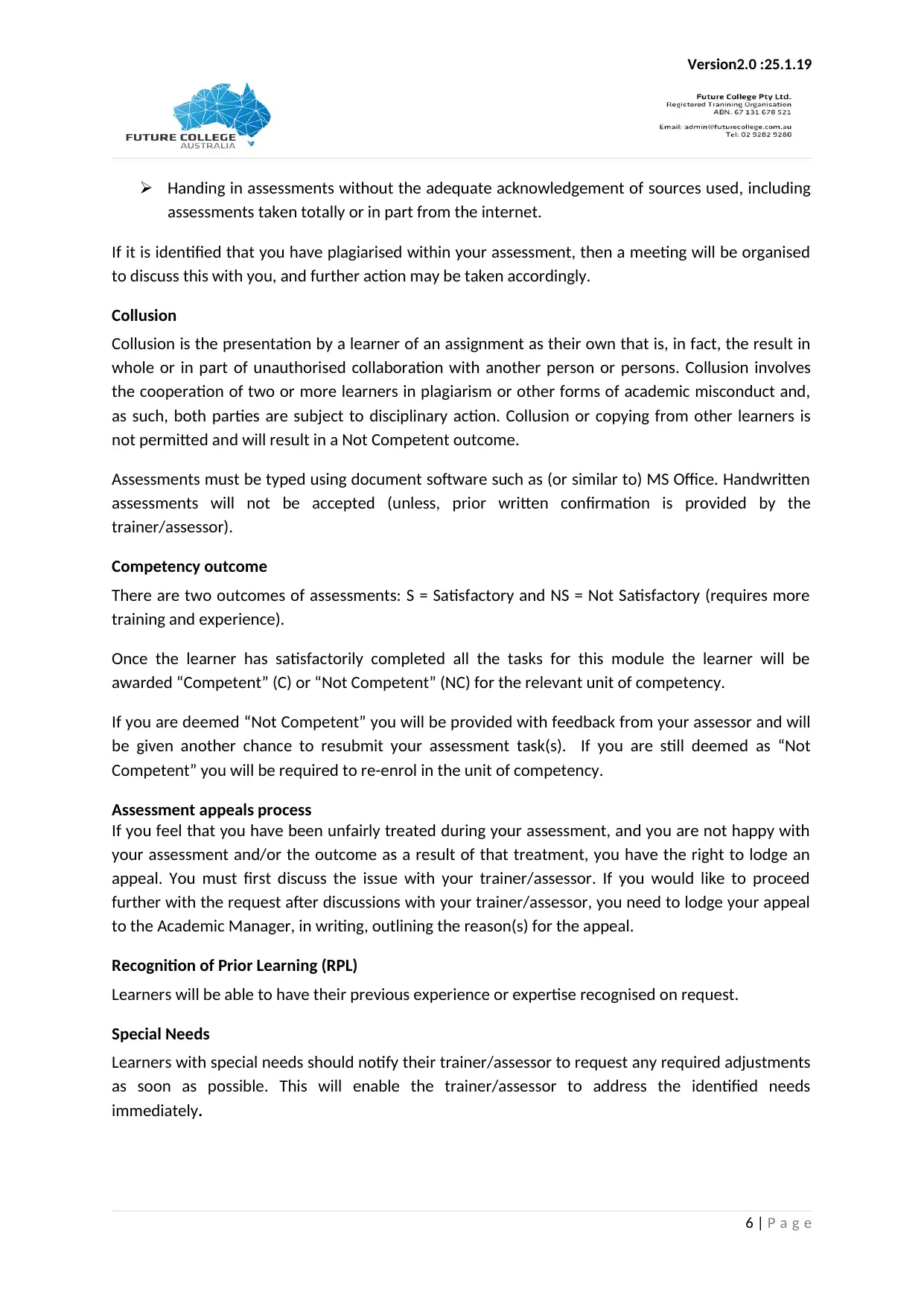
Version2.0 :25.1.19
Handing in assessments without the adequate acknowledgement of sources used, including
assessments taken totally or in part from the internet.
If it is identified that you have plagiarised within your assessment, then a meeting will be organised
to discuss this with you, and further action may be taken accordingly.
Collusion
Collusion is the presentation by a learner of an assignment as their own that is, in fact, the result in
whole or in part of unauthorised collaboration with another person or persons. Collusion involves
the cooperation of two or more learners in plagiarism or other forms of academic misconduct and,
as such, both parties are subject to disciplinary action. Collusion or copying from other learners is
not permitted and will result in a Not Competent outcome.
Assessments must be typed using document software such as (or similar to) MS Office. Handwritten
assessments will not be accepted (unless, prior written confirmation is provided by the
trainer/assessor).
Competency outcome
There are two outcomes of assessments: S = Satisfactory and NS = Not Satisfactory (requires more
training and experience).
Once the learner has satisfactorily completed all the tasks for this module the learner will be
awarded “Competent” (C) or “Not Competent” (NC) for the relevant unit of competency.
If you are deemed “Not Competent” you will be provided with feedback from your assessor and will
be given another chance to resubmit your assessment task(s). If you are still deemed as “Not
Competent” you will be required to re-enrol in the unit of competency.
Assessment appeals process
If you feel that you have been unfairly treated during your assessment, and you are not happy with
your assessment and/or the outcome as a result of that treatment, you have the right to lodge an
appeal. You must first discuss the issue with your trainer/assessor. If you would like to proceed
further with the request after discussions with your trainer/assessor, you need to lodge your appeal
to the Academic Manager, in writing, outlining the reason(s) for the appeal.
Recognition of Prior Learning (RPL)
Learners will be able to have their previous experience or expertise recognised on request.
Special Needs
Learners with special needs should notify their trainer/assessor to request any required adjustments
as soon as possible. This will enable the trainer/assessor to address the identified needs
immediately .
6 | P a g e
Handing in assessments without the adequate acknowledgement of sources used, including
assessments taken totally or in part from the internet.
If it is identified that you have plagiarised within your assessment, then a meeting will be organised
to discuss this with you, and further action may be taken accordingly.
Collusion
Collusion is the presentation by a learner of an assignment as their own that is, in fact, the result in
whole or in part of unauthorised collaboration with another person or persons. Collusion involves
the cooperation of two or more learners in plagiarism or other forms of academic misconduct and,
as such, both parties are subject to disciplinary action. Collusion or copying from other learners is
not permitted and will result in a Not Competent outcome.
Assessments must be typed using document software such as (or similar to) MS Office. Handwritten
assessments will not be accepted (unless, prior written confirmation is provided by the
trainer/assessor).
Competency outcome
There are two outcomes of assessments: S = Satisfactory and NS = Not Satisfactory (requires more
training and experience).
Once the learner has satisfactorily completed all the tasks for this module the learner will be
awarded “Competent” (C) or “Not Competent” (NC) for the relevant unit of competency.
If you are deemed “Not Competent” you will be provided with feedback from your assessor and will
be given another chance to resubmit your assessment task(s). If you are still deemed as “Not
Competent” you will be required to re-enrol in the unit of competency.
Assessment appeals process
If you feel that you have been unfairly treated during your assessment, and you are not happy with
your assessment and/or the outcome as a result of that treatment, you have the right to lodge an
appeal. You must first discuss the issue with your trainer/assessor. If you would like to proceed
further with the request after discussions with your trainer/assessor, you need to lodge your appeal
to the Academic Manager, in writing, outlining the reason(s) for the appeal.
Recognition of Prior Learning (RPL)
Learners will be able to have their previous experience or expertise recognised on request.
Special Needs
Learners with special needs should notify their trainer/assessor to request any required adjustments
as soon as possible. This will enable the trainer/assessor to address the identified needs
immediately .
6 | P a g e
Paraphrase This Document
Need a fresh take? Get an instant paraphrase of this document with our AI Paraphraser
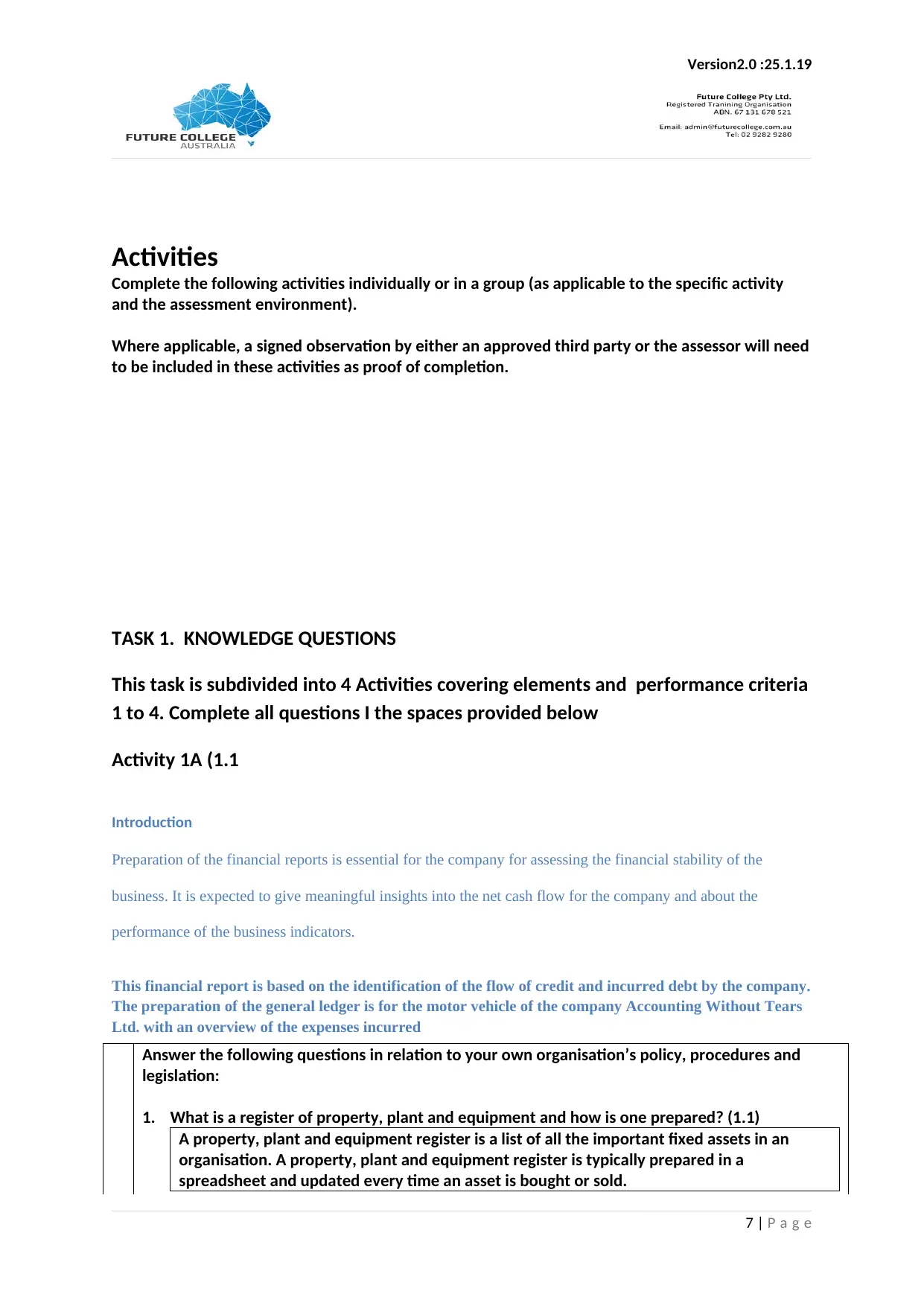
Version2.0 :25.1.19
Activities
Complete the following activities individually or in a group (as applicable to the specific activity
and the assessment environment).
Where applicable, a signed observation by either an approved third party or the assessor will need
to be included in these activities as proof of completion.
TASK 1. KNOWLEDGE QUESTIONS
This task is subdivided into 4 Activities covering elements and performance criteria
1 to 4. Complete all questions I the spaces provided below
Activity 1A (1.1
Introduction
Preparation of the financial reports is essential for the company for assessing the financial stability of the
business. It is expected to give meaningful insights into the net cash flow for the company and about the
performance of the business indicators.
This financial report is based on the identification of the flow of credit and incurred debt by the company.
The preparation of the general ledger is for the motor vehicle of the company Accounting Without Tears
Ltd. with an overview of the expenses incurred
Answer the following questions in relation to your own organisation’s policy, procedures and
legislation:
1. What is a register of property, plant and equipment and how is one prepared? (1.1)
A property, plant and equipment register is a list of all the important fixed assets in an
organisation. A property, plant and equipment register is typically prepared in a
spreadsheet and updated every time an asset is bought or sold.
7 | P a g e
Activities
Complete the following activities individually or in a group (as applicable to the specific activity
and the assessment environment).
Where applicable, a signed observation by either an approved third party or the assessor will need
to be included in these activities as proof of completion.
TASK 1. KNOWLEDGE QUESTIONS
This task is subdivided into 4 Activities covering elements and performance criteria
1 to 4. Complete all questions I the spaces provided below
Activity 1A (1.1
Introduction
Preparation of the financial reports is essential for the company for assessing the financial stability of the
business. It is expected to give meaningful insights into the net cash flow for the company and about the
performance of the business indicators.
This financial report is based on the identification of the flow of credit and incurred debt by the company.
The preparation of the general ledger is for the motor vehicle of the company Accounting Without Tears
Ltd. with an overview of the expenses incurred
Answer the following questions in relation to your own organisation’s policy, procedures and
legislation:
1. What is a register of property, plant and equipment and how is one prepared? (1.1)
A property, plant and equipment register is a list of all the important fixed assets in an
organisation. A property, plant and equipment register is typically prepared in a
spreadsheet and updated every time an asset is bought or sold.
7 | P a g e
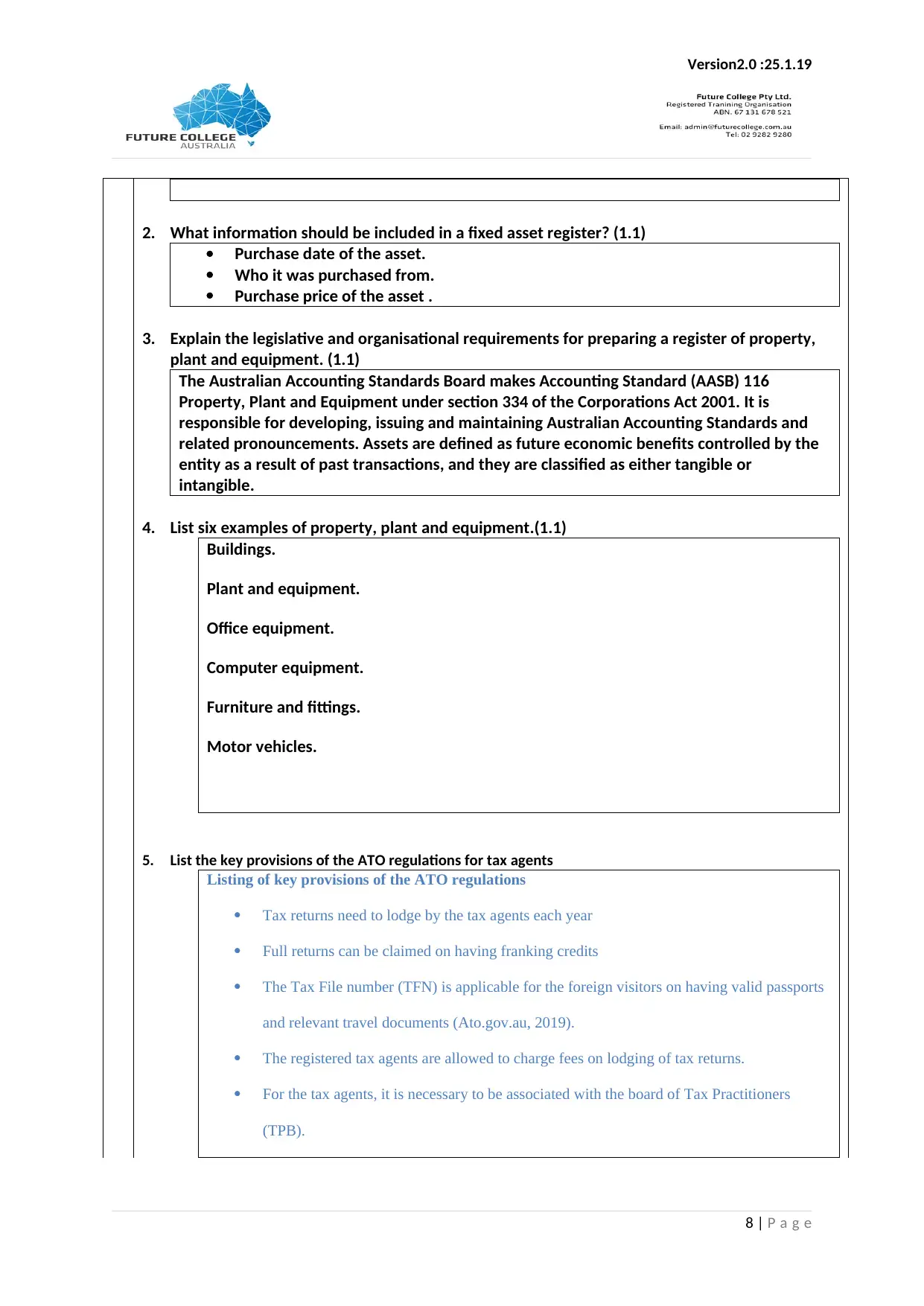
Version2.0 :25.1.19
2. What information should be included in a fixed asset register? (1.1)
Purchase date of the asset.
Who it was purchased from.
Purchase price of the asset .
3. Explain the legislative and organisational requirements for preparing a register of property,
plant and equipment. (1.1)
The Australian Accounting Standards Board makes Accounting Standard (AASB) 116
Property, Plant and Equipment under section 334 of the Corporations Act 2001. It is
responsible for developing, issuing and maintaining Australian Accounting Standards and
related pronouncements. Assets are defined as future economic benefits controlled by the
entity as a result of past transactions, and they are classified as either tangible or
intangible.
4. List six examples of property, plant and equipment.(1.1)
Buildings.
Plant and equipment.
Office equipment.
Computer equipment.
Furniture and fittings.
Motor vehicles.
5. List the key provisions of the ATO regulations for tax agents
Listing of key provisions of the ATO regulations
Tax returns need to lodge by the tax agents each year
Full returns can be claimed on having franking credits
The Tax File number (TFN) is applicable for the foreign visitors on having valid passports
and relevant travel documents (Ato.gov.au, 2019).
The registered tax agents are allowed to charge fees on lodging of tax returns.
For the tax agents, it is necessary to be associated with the board of Tax Practitioners
(TPB).
8 | P a g e
2. What information should be included in a fixed asset register? (1.1)
Purchase date of the asset.
Who it was purchased from.
Purchase price of the asset .
3. Explain the legislative and organisational requirements for preparing a register of property,
plant and equipment. (1.1)
The Australian Accounting Standards Board makes Accounting Standard (AASB) 116
Property, Plant and Equipment under section 334 of the Corporations Act 2001. It is
responsible for developing, issuing and maintaining Australian Accounting Standards and
related pronouncements. Assets are defined as future economic benefits controlled by the
entity as a result of past transactions, and they are classified as either tangible or
intangible.
4. List six examples of property, plant and equipment.(1.1)
Buildings.
Plant and equipment.
Office equipment.
Computer equipment.
Furniture and fittings.
Motor vehicles.
5. List the key provisions of the ATO regulations for tax agents
Listing of key provisions of the ATO regulations
Tax returns need to lodge by the tax agents each year
Full returns can be claimed on having franking credits
The Tax File number (TFN) is applicable for the foreign visitors on having valid passports
and relevant travel documents (Ato.gov.au, 2019).
The registered tax agents are allowed to charge fees on lodging of tax returns.
For the tax agents, it is necessary to be associated with the board of Tax Practitioners
(TPB).
8 | P a g e
⊘ This is a preview!⊘
Do you want full access?
Subscribe today to unlock all pages.

Trusted by 1+ million students worldwide
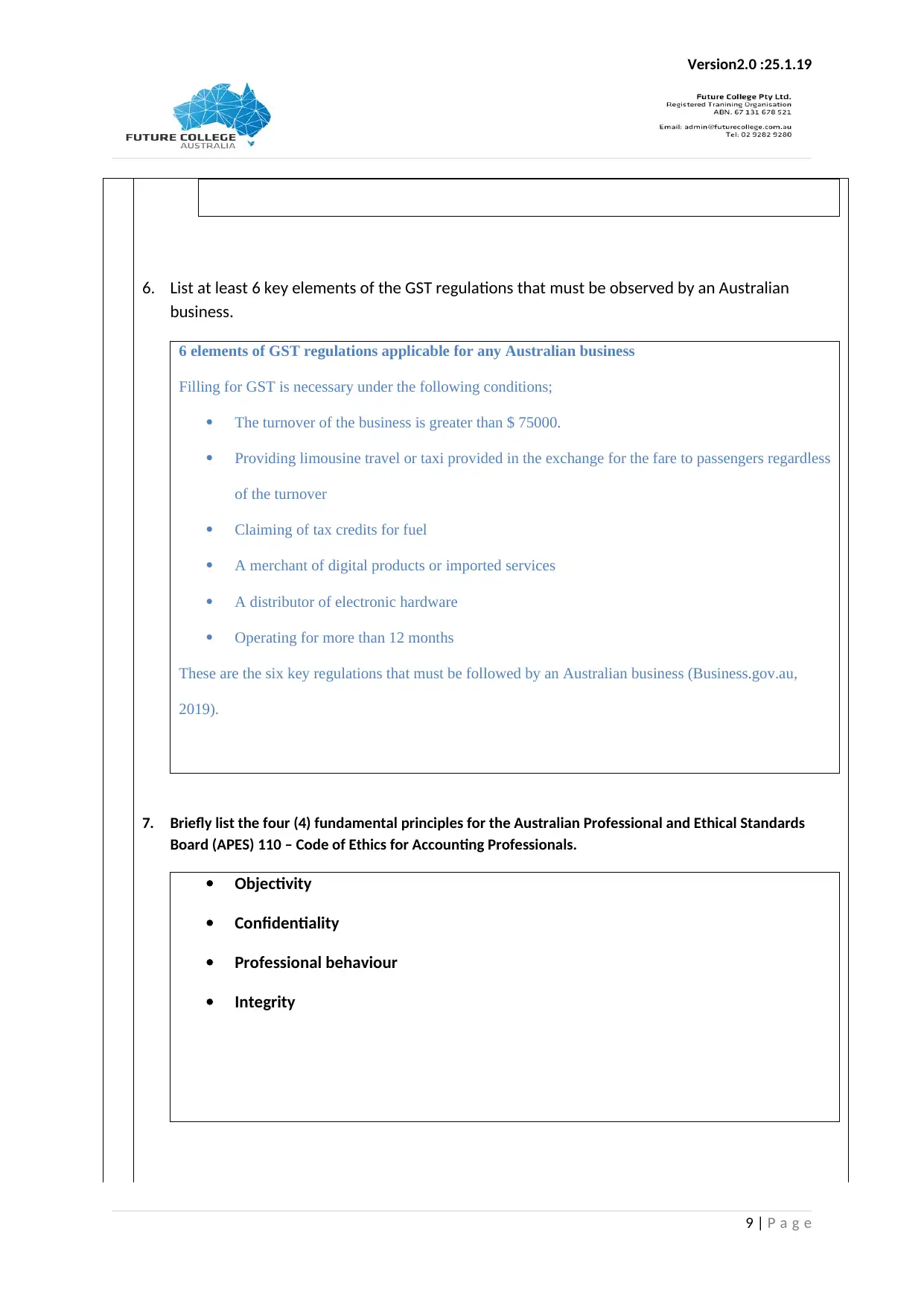
Version2.0 :25.1.19
6. List at least 6 key elements of the GST regulations that must be observed by an Australian
business.
6 elements of GST regulations applicable for any Australian business
Filling for GST is necessary under the following conditions;
The turnover of the business is greater than $ 75000.
Providing limousine travel or taxi provided in the exchange for the fare to passengers regardless
of the turnover
Claiming of tax credits for fuel
A merchant of digital products or imported services
A distributor of electronic hardware
Operating for more than 12 months
These are the six key regulations that must be followed by an Australian business (Business.gov.au,
2019).
7. Briefly list the four (4) fundamental principles for the Australian Professional and Ethical Standards
Board (APES) 110 – Code of Ethics for Accounting Professionals.
Objectivity
Confidentiality
Professional behaviour
Integrity
9 | P a g e
6. List at least 6 key elements of the GST regulations that must be observed by an Australian
business.
6 elements of GST regulations applicable for any Australian business
Filling for GST is necessary under the following conditions;
The turnover of the business is greater than $ 75000.
Providing limousine travel or taxi provided in the exchange for the fare to passengers regardless
of the turnover
Claiming of tax credits for fuel
A merchant of digital products or imported services
A distributor of electronic hardware
Operating for more than 12 months
These are the six key regulations that must be followed by an Australian business (Business.gov.au,
2019).
7. Briefly list the four (4) fundamental principles for the Australian Professional and Ethical Standards
Board (APES) 110 – Code of Ethics for Accounting Professionals.
Objectivity
Confidentiality
Professional behaviour
Integrity
9 | P a g e
Paraphrase This Document
Need a fresh take? Get an instant paraphrase of this document with our AI Paraphraser
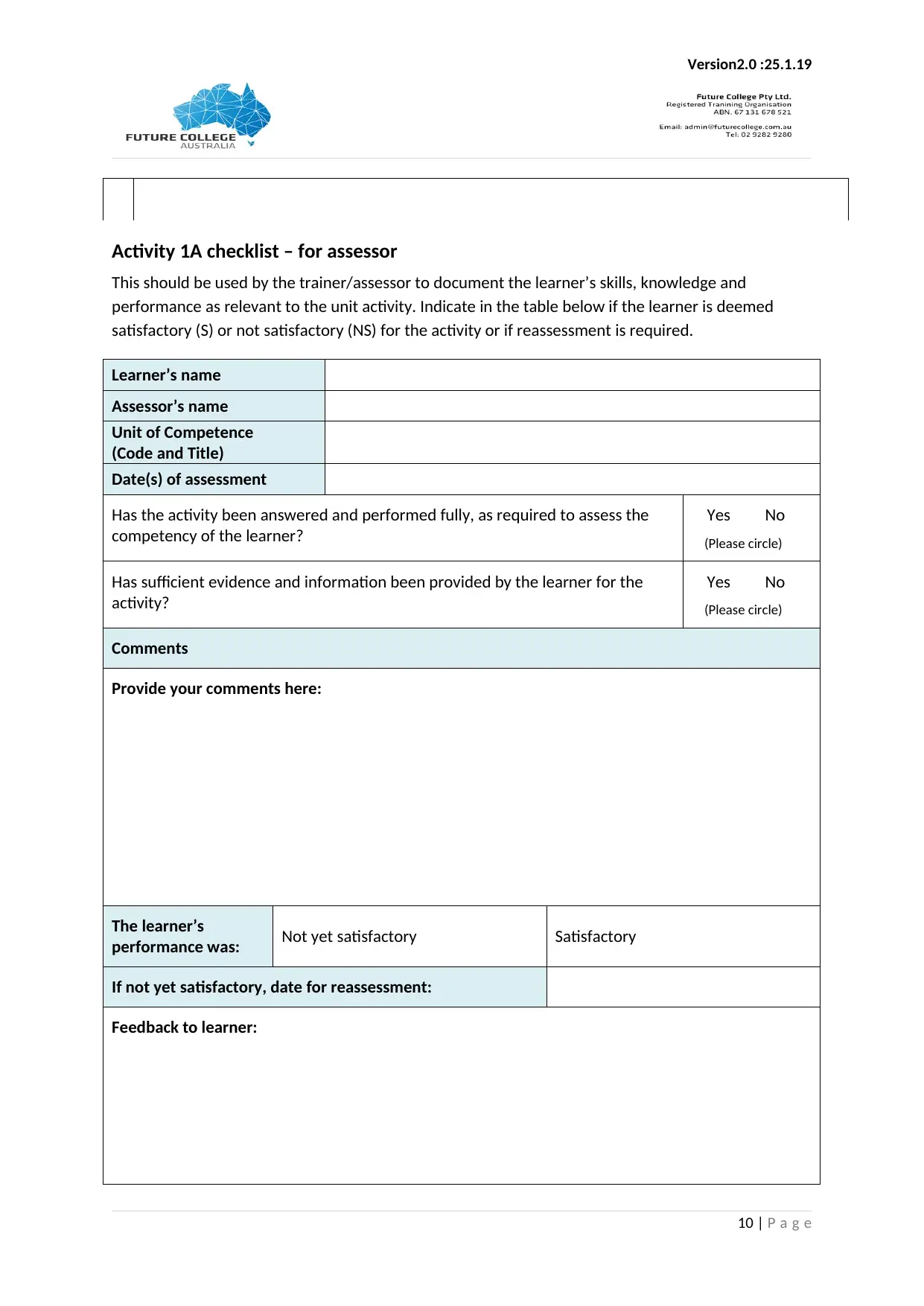
Version2.0 :25.1.19
Activity 1A checklist – for assessor
This should be used by the trainer/assessor to document the learner’s skills, knowledge and
performance as relevant to the unit activity. Indicate in the table below if the learner is deemed
satisfactory (S) or not satisfactory (NS) for the activity or if reassessment is required.
Learner’s name
Assessor’s name
Unit of Competence
(Code and Title)
Date(s) of assessment
Has the activity been answered and performed fully, as required to assess the
competency of the learner?
Yes No
(Please circle)
Has sufficient evidence and information been provided by the learner for the
activity?
Yes No
(Please circle)
Comments
Provide your comments here:
The learner’s
performance was: Not yet satisfactory Satisfactory
If not yet satisfactory, date for reassessment:
Feedback to learner:
10 | P a g e
Activity 1A checklist – for assessor
This should be used by the trainer/assessor to document the learner’s skills, knowledge and
performance as relevant to the unit activity. Indicate in the table below if the learner is deemed
satisfactory (S) or not satisfactory (NS) for the activity or if reassessment is required.
Learner’s name
Assessor’s name
Unit of Competence
(Code and Title)
Date(s) of assessment
Has the activity been answered and performed fully, as required to assess the
competency of the learner?
Yes No
(Please circle)
Has sufficient evidence and information been provided by the learner for the
activity?
Yes No
(Please circle)
Comments
Provide your comments here:
The learner’s
performance was: Not yet satisfactory Satisfactory
If not yet satisfactory, date for reassessment:
Feedback to learner:
10 | P a g e

Version2.0 :25.1.19
Learner’s signature
Assessor’s signature
11 | P a g e
Learner’s signature
Assessor’s signature
11 | P a g e
⊘ This is a preview!⊘
Do you want full access?
Subscribe today to unlock all pages.

Trusted by 1+ million students worldwide
1 out of 58
Related Documents
Your All-in-One AI-Powered Toolkit for Academic Success.
+13062052269
info@desklib.com
Available 24*7 on WhatsApp / Email
![[object Object]](/_next/static/media/star-bottom.7253800d.svg)
Unlock your academic potential
Copyright © 2020–2025 A2Z Services. All Rights Reserved. Developed and managed by ZUCOL.





